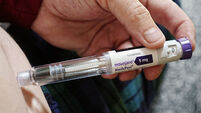Pinprick blood test could detect disease 10 years before symptoms appear, study finds

Predictive tests will shift healthcare towards prevention rather then treatment.
The world’s largest study into key substances in the bloodstream has paved the way for a swathe of pinprick tests that can detect early signs of disease more than a decade before symptoms appear, researchers say.
Work on the tests follows the completion of a project by UK Biobank to measure the levels of nearly 250 different proteins, sugars, fats and other compounds in blood collected from half a million volunteers.
The complex molecular profiles give a detailed snapshot of each person’s physiology, and when combined with medical records and death registries, allow scientists to predict the risk of a host of diseases from diabetes and heart disease to cancer and dementia.
“It’s going to be a real gamechanger for our work,” said Dr Joy Edwards-Hicks at the University of Edinburgh, who studies how changes in blood metabolites affect the immune system. More predictive tests will shift the emphasis in healthcare towards preventing diseases rather than treating them.
“It fits with the model of prevention that we are moving towards, to be able to send off a little pinprick blood sample and get an idea of your health,” she added. “If we have early predictors of disease, we can tell someone in their 40s that their biomarkers are not looking good for their age and advise on changes they could make.”
The project measured hundreds of key metabolites in the blood, including sugars, amino acids, fats, precursors for hormones and waste products such as urea. The molecules are produced or used when the body breaks down food, drink and medicines, and when organs use energy, make repairs and build fresh tissues for growth.
Changes in people’s metabolic profiles reflect and drive disease. When organs stop working properly, the profile will shift. A diseased liver can drive up ammonia. A damaged kidney can increase urea and creatinine. Muscle damage can be seen in raised lactate. In cancer, glucose uptake rises.
The picture scientists glean from metabolic profiles is often more comprehensive than other tests allow. This is because metabolites are influenced not only by a person’s genetics, but where they live and how they live: diet, exercise, exposure to pollution and stress all feed in.
“These metabolic profiles capture all of the genetic predisposition and the downstream consequences of that, as well as the environmental exposures, so it gives us a snapshot of a person’s physiological state,” said Dr Julian Mutz at King’s College London. “It’s also highly dynamic, whereas genetics, for example, is fixed.”
Researchers have already had access to some metabolic profiles through the UK Biobank, but having profiles for 500,000 volunteers means they can develop tests that pick up early signs of disease more reliably and for a broader range of conditions.
Dr Mutz uses metabolic profiles to predict the risk of dementia. If tests can reveal 10 to 15 years in advance that a person is at greater risk, doctors can intervene early to help patients reduce the odds of developing the condition. The new data should drive progress on predicting rarer forms of neurodegenerative disease, such as frontotemporal dementia.
UK Biobank started recruiting volunteers in 2006. It allows approved scientists to find links between lifestyle, genetics, the environment and health by combining medical records, imaging and now, a full set of metabolic profiles.












